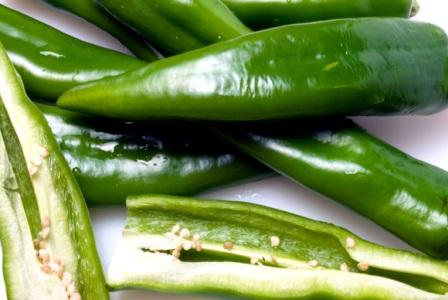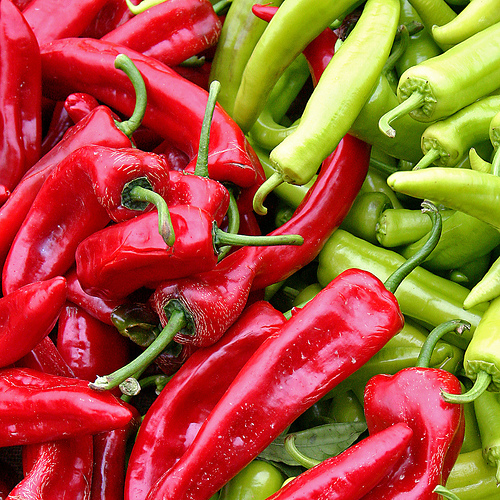Insider Facts About Green Chiles, 2 day 20% OFF special on classes
 Green chile season is here! In New Mexico we have historically created more special green chile recipes than perhaps anywhere in the world. Included are such innovations as Green Chile Apple Pie and Green Chile Crusted Quiches. And...green chile season is upon us...yeah. Green chiles have such a distinctive flavor that is habit forming with many of us.
Green chile season is here! In New Mexico we have historically created more special green chile recipes than perhaps anywhere in the world. Included are such innovations as Green Chile Apple Pie and Green Chile Crusted Quiches. And...green chile season is upon us...yeah. Green chiles have such a distinctive flavor that is habit forming with many of us.
There's lots to know about selecting the best chiles for your palate or family. First, green chiles are highly perishable and are best parched or readied for the table as soon as possible after picking. You can tell fresh green chiles by looking at the stem. The stem should be fresh and green looking, not dry and withered. Fresher chiles will be waxy green and firm to the touch, not springy and wrinkled.
 You can tell the mildness of a chile by looking at the contour of the chile--milder ones have broad shoulders (next to the stem) and blunter ends--not pointed. The reason this is significant is that a single plant can have as many as 15 different piquancy variations at one time. The reason for this is at the time of fruiting, when the blossom becomes a fruit or chile, the amount of moisture on the leaves or roots will determine the mildness. The more moisture, the milder the chile. So if you wish hotter ones, look for the pointed tips and sloping shoulders--there can be a variation of as much as 15,000 Scoville units between the mildest ones of any variety and the hottest ones.
You can tell the mildness of a chile by looking at the contour of the chile--milder ones have broad shoulders (next to the stem) and blunter ends--not pointed. The reason this is significant is that a single plant can have as many as 15 different piquancy variations at one time. The reason for this is at the time of fruiting, when the blossom becomes a fruit or chile, the amount of moisture on the leaves or roots will determine the mildness. The more moisture, the milder the chile. So if you wish hotter ones, look for the pointed tips and sloping shoulders--there can be a variation of as much as 15,000 Scoville units between the mildest ones of any variety and the hottest ones.
Many people wonder about the difference in nutrition between green chiles, which are a seasonal unripe chile , and red chiles. The amount of capsaicin, the source of the "heat" or piquancy in any chile--whether red or green will be the same for that variety. The hotter the chile, the more capsaicin, which is the health producing substance within a chile. Nutritionally there is a rather large variation. Green chiles are a good source of vitamin C, and as they ripen and turn red, the red chiles are a good source of vitamin A--with the red chiles containing much less vitamin C. Chiles become red, seasonally. In the fall, when the days become shorter and the weather is cooler, which in New Mezico starts in October and lasts until the first frost, usually in November.
With the seasonality, for local chiles--especially in the New Mexico area, many wish to freeze them . Almost all large super markets, fruit stands and small green chile stands are now starting to offer what they call chile roasting in a steel mesh rotating drum with a blow torch directed into the rotating chiles.
I have forever been opposed to the results of this method, which makes the chiles have blackened speckles of charred skin. And then, once the 40 pound sacks are what they call roasted, are placed in a large plastic bag--a perfect incubator for salmonella--a great stomach ache producer.
My favorite method is to parch the chiles over or under direct heat such as in a grill at 500 degrees or under an electric broiler. Then once the skins are uniformly blistered to a dark brown, they should be plunged immediately in very cold or ice water. This stops the cooking and the steaming and dehydration, resulting in dense, bright green flesh of the chile. Below, I am giving you my favorite parching directions. (Roasting by the way is when you cook or roast a food all the way through. Parching is when you just blister the outside.)
 Dishes, such as Green Chile Stew will have a distinctive flavor, much different than in Bowl of Red type of Chilis . Some people are highly opinionated and prefer one or the other, while others, like myself, like it all--the hotter the better within reason.
Dishes, such as Green Chile Stew will have a distinctive flavor, much different than in Bowl of Red type of Chilis . Some people are highly opinionated and prefer one or the other, while others, like myself, like it all--the hotter the better within reason.
You can use green chiles in many different ways--from appetizers to main courses to desserts and yes, even for creating wines and brandies.
For more in depth information and cooking tips and hints with green chiles, register for our full participation cooking class August 26 or register for our online class--both of which are on a 20% off 2 day sale. Our August 20-22 weekend full participation class and our October 25-29 week long full participation week long class are also on a 20% off sale.
Here is my favorite way to parch and freeze green chiles--
PARCHING FRESH GREEN CHILES
When you cook with fresh green chiles, I recommend that you parch or roast them to remove the tough outer skin. The process—intense direct heat on the peel of the chile that leaves the flesh uncooked—is easy enough, but if you are not used to the sting of chiles, you may want to wear rubber gloves or generously butter your hands to prevent a burn from the chiles’ irritating oils.
To parch chiles, first wash them, removing all sand and dirt. Leave the stem on, then pierce each one with a sharp knife, about 1 inch down from the stem.
To Parch a Few Chiles: Set up an ice water bath in a large bowl next to the stove. Place each chile directly on a medium-hot electric burner surface unit, or hold it with tongs or a meat fork over a gas burner on medium-high heat. Using tongs, carefully rotate the chiles until the skin is charred on all sides, about about 2 to 5 minutes, then plunge the roasted chiles into the ice bath. Allow the chiles to soak until cool to the touch, then use your fingers to peel away the skin from stem to tip.
To Parch Large Quantities of Chiles: If using an electric oven, cover the entire top rack with heavy aluminum foil and place it four inches from the broiler unit. If yours is a gas oven, cover the broiler rack with foil and place the rack in the closest position to the broiler. (For smaller quantities, cover a baking sheet with foil, and place it on an uncovered rack.)
Preheat the broiler. Or, preheat the outdoor grill to 500 F. Set up an ice water bath in the sink or a very large bowl. When the broiler is hot, carefully place a single layer of chiles on the foil-covered rack or baking sheet and cook until the skin begins to blister on top, about 1 to 2 minutes. Carefully turn the chiles using long tongs or a metal meat fork, and continue to cook until the skins are blistered all over, about 3 to 4 minutes more. Watch the chiles closely—they burn quickly. As soon as the chiles are parched, immerse them in the ice water bath. Once the chiles have cooled to the touch, simply pull off the skin in strips, working from the stem to the tip—it should come away easily.
Keep the stems on if preparing chiles rellenos, or remove them if using the chiles in other ways. For a milder roasted chile, slice open the pods and strip out the seeds and veins with the backside of a knife.
Freezing Parched Chiles
Once you’ve prepared your chiles, you can use them right away or freeze them for later use.
To freeze parched chiles, drain them well after removing them from the ice water bath, then place them on cookie sheets and freeze them (Do not peel the chiles—leaving the skin on now gives you more flexibility of use later) Package the flash-frozen chiles in plastic freezer bags. To use in a recipe, prepare the chiles as needed.
Search Blog
Subscribe to Blog
Categories
Tags
Baking barbecue cookbook Benefits of Pure Chiles blue corn products chii chile and tomatillo seeds Chiles Cinnamon discounted cooking classes Discounted products Flan full particiipation cooking class Hotter Than Hell New Mexican Holiday Favorites Oaxaca Oaxacan recipes pure ground chiles Quick and Easy Recipe week long cooking class weekend cooking class western book© Copyright 2025 All Rights Reserved. TEX MEX Inc. Privacy Policy.
Jane Butel Cooking School • Pecos Valley Spice Co. • Corrales, NM 87048 • Office: 505-243-2622 • info@janebutelcooking.com | Jane Butel Home Page
To ensure delivery of emails from my website please whitelist: info@janebutelcooking.com





